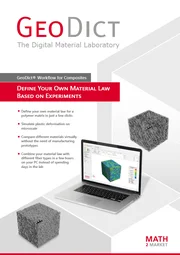Compute Mechanics & Deformation
ElastoDict
ElastoDict helps characterizing the mechanical properties of complex materials and allows to understand and optimize the material using accurate simulations on the 3D microstructure. For example, it is possible to carry out simulations of anisotropic stiffness, damage, and material failure. As you are used to in GeoDict, you can compute directly on 3D image data, like for example from micro-CT scans or from FIB-SEM measurements. No time-consuming meshing of the data is required. ElastoDict then simulates directly on the segmented image data, which simplifies the process considerably.
Furthermore, the properties of new material designs can be computed on 3D structural models, which can be created with GeoDict’s structure generators, e.g. with FiberGeo, PaperGeo or GrainGeo. The exact results at the microstructure scale can be used to improve component simulations. As all other GeoDict modules, ElastoDict runs directly on the voxel geometry. Compared to traditional finite element simulations, this removes a complex preparation step and makes it much easier to start with simulations.
Using simulations to find answers to mechanical properties and deformation questions is key for a wide range of materials. For example, the ElastoDict module can be used to simulate how the clamping pressure changes the structure of a gas diffusion layer (GDL) in a PEM fuel cell, or how the properties of rock samples change under in-situ conditions.
All these ElastoDict simulations run at high-speed and in a extremely memory-efficient way with the FeelMath solver integrated in ElastoDict and developed at the Fraunhofer ITWM.
Effective Stiffness
The Effective Stiffness sub-module accurately computes the linear elastic properties of complex micro-structures by solving the corresponding partial differential equation directly on the 3D voxel image. The results include the local strain, stress, and displacement fields, the complete stiffness tensor, and the information on the orthotropic, transversal isotropic or isotropic character of the material. Additionally, many post-processing steps can be carried out on the effective stiffness results.
In addition, the GeoDict Result Viewer offers many tools for further analysis of the results. This feature allows for in-depth analysis and provides further insight into the material behavior, enhancing the understanding of its mechanical response and potential optimizations.
Additionally, the Effective Stiffness-AF option allows to calculate a quick estimate of the complete stiffness tensor of the microstructure based on analytic approximations.
Deformations
With the Deformations submodule, complex deformation simulations which consider nonlinear effects can be performed. For example, a standard tensile experiment in an arbitrary direction of the 3D micro-structure can be set up. The models of the constituent materials might contain damage, failure, plastic deformation, viscous effects, and many more. Additionally, it is possible to create user-defined material subroutines using the UMAT interface (compatible with Abaqus).
Results of the simulation are for example a strain-stress curve and local information on the regions where damage sets in and the material ends up failing. Cyclic load experiments or shear experiments are also possible. ElastoDict-Deformations also delivers deformed 3D structures from each computed deformation step for visualization and further analysis.
Flexural Test
With the Flexural Test option in ElastoDict, the reaction of a material to bending loads can be analyzed. 3-point bending tests can be simulated and directly compared with laboratory results. As in most applications in GeoDict, only a small representative section of the structure is needed for the simulation. However, it is necessary that the structure in GeoDict contains the complete height of the beam.
The flexural test option is based on the Deformations option and supports all types of material laws which are supported there, especially plasticity, damage and failure.

GeoDict Online User Guide
Following Modules are often used in combination with ElastoDict:
| Image Processing and Image Analysis | ImportGeo-Vol | |||||
| Material Analysis | GrainFind | FiberFind | PoroDict + MatDict | |||
| Modeling & Design | GrainGeo | FiberGeo | FoamGeo | PleatGeo | WeaveGeo | PaperGeo |
| Simulation & Prediction |
Suitable modules depend on the concrete application.










